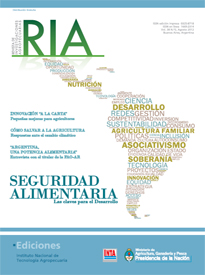Ver ítem
- xmlui.general.dspace_homeCentros e Institutos de InvestigaciónCICVyA. Centro de Investigación en Ciencias Veterinarias y AgronómicasInstituto de Microbiología y Zoología AgrícolaArtículos científicosxmlui.ArtifactBrowser.ItemViewer.trail
- Inicio
- Centros e Institutos de Investigación
- CICVyA. Centro de Investigación en Ciencias Veterinarias y Agronómicas
- Instituto de Microbiología y Zoología Agrícola
- Artículos científicos
- Ver ítem
Capacidad de las macrofitas Lemna minor y Eichhornia crassipes para eliminar el níquel
Resumen
El objetivo de este trabajo fue estudiar la capacidad de dos especies de macrofitas, Lemna minor y Eichhornia crassipes, para eliminar el níquel. Se realizaron cuatro tratamientos durante dos semanas para cada una de las especies. Las plantas fueron incubadas con 0, 1, 3 y 6 mg l-1 de Ni. Ambas especies mostraron, en todos los tratamientos con Ni, una reducción en la concentración a lo largo del tiempo. L. minor mostró ser más eficiente para remover este
[ver mas...]
El objetivo de este trabajo fue estudiar la capacidad de dos especies de macrofitas, Lemna minor y Eichhornia crassipes, para eliminar el níquel. Se realizaron cuatro tratamientos durante dos semanas para cada una de las especies. Las plantas fueron incubadas con 0, 1, 3 y 6 mg l-1 de Ni. Ambas especies mostraron, en todos los tratamientos con Ni, una reducción en la concentración a lo largo del tiempo. L. minor mostró ser más eficiente para remover este ión a la más baja concentración. Sin embargo, en concentraciones más elevadas no se observaron diferencias entre ambas especies. El análisis del tejido de las plantas mostró que las mismas acumulaban el metal, en los tres casos evaluados con concentraciones diferentes.
[Cerrar]
The aim of this work was to study the capacity of two macrophyte species, Lemna minor and Eichhornia
crassipes to remove nickel. Four treatments were carried out for two weeks with each species: plants were
either incubated with 0, 1, 3 and 6 mgl-1 de Ni. All treatments with both plants showed a decrease in Ni concentration over time. L. minor proved to be more efficient to remove the ion at the lowest concentration. At higher concentrations, however,
[ver mas...]
The aim of this work was to study the capacity of two macrophyte species, Lemna minor and Eichhornia
crassipes to remove nickel. Four treatments were carried out for two weeks with each species: plants were
either incubated with 0, 1, 3 and 6 mgl-1 de Ni. All treatments with both plants showed a decrease in Ni concentration over time. L. minor proved to be more efficient to remove the ion at the lowest concentration. At higher concentrations, however, no differences were observed between both species. The analysis of plant tissue showed that plants accumulated the metal at the three concentrations evaluated.
[Cerrar]

Fuente
RIA 38 (2) : 153-157 (agosto 2012)
Fecha
2012-08
Editorial
Gerencia de Comunicación e Imagen Institucional, DNA SICC, INTA
ISSN
0325-8718
1669-2314
1669-2314
Formato
pdf
Tipo de documento
artículo
Palabras Claves
Derechos de acceso
Abierto
 Excepto donde se diga explicitamente, este item se publica bajo la siguiente descripción: Creative Commons Attribution-NonCommercial-ShareAlike 2.5 Unported (CC BY-NC-SA 2.5)
Excepto donde se diga explicitamente, este item se publica bajo la siguiente descripción: Creative Commons Attribution-NonCommercial-ShareAlike 2.5 Unported (CC BY-NC-SA 2.5)


